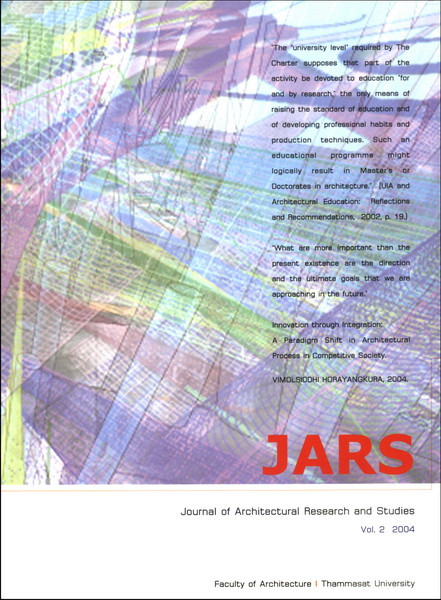Transformation of the Canal-Side Settlements in Greater Bangkok
Main Article Content
Abstract
This paper presents a case study of canal-side settlements [1] in greater Bangkok, which focused on canalside settlements transformed by modernization over a period of time. Three different sets of data, from every twenty years in the years 1952, 1974 and 1998 compiled through the aerial photographic interpretation technique were examined, and a survey research and field survey were undertaken, which were based on the investigation of different houses and different locations of settlements that have affected the inhabitant’s altitude towards environmental concerns. The paper examined two levels in the study for the purpose of (1) the analysis of settlement structure (fabric pattern of settlement) (2) the analysis of change in building types from old types to new types. The findings found that changes in building construction types, which occurred as dwelling, were built in modern style and materials. First, the settlement structure has varied by sites which are related to factors such as space, canals, roads, land sub-divisions, and site patterns in different locations in greater Bangkok. Second, changes in building construction type occurred and dwellings were built in modern styles and materials. Moreover, those changes of building types are correlated with the change in settlement structures in the same way. The transformation process of house forms indicated the change from a traditional to a modern type, which took over forty years in Bangkhu Wiang (urban-fringe), Klong 9-10 and Sai Gong Din (suburb area). Meanwhile the process took twenty years in Mahasawat (urban) since it was the nearest to the CBD.
Downloads
Article Details

This work is licensed under a Creative Commons Attribution-NonCommercial-NoDerivatives 4.0 International License.
All material is licensed under the terms of the Creative Commons Attribution 4.0 International (CC-BY-NC-ND 4.0) License, unless otherwise stated. As such, authors are free to share, copy, and redistribute the material in any medium or format. The authors must give appropriate credit, provide a link to the license, and indicate if changes were made. The authors may do so in any reasonable manner, but not in any way that suggests the licensor endorses you or your use. The authors may not use the material for commercial purposes. If the authors remix, transform, or build upon the material, they may not distribute the modified material, unless permission is obtained from JARS. Final, accepted versions of the paper may be posted on third party repositories, provided appropriate acknowledgement to the original source is clearly noted.
References
Sumet Jumsai. Naga-Oceanic Origin of Culture in Siam and the West Pacific. New York: Oxford University Press, 1988. p.8.
Eerdinaral Toenies. “From Community to Society” in Social Change. quoted in Eva Etzioni-Halevy and Amitai Etzioni 2nd edition. 1964. p.57.
Joseph R. Gusfield. “Tradition and Modernity Misplaced Polarities” in the study of Social Change, 1964.
Chatthip Nartsupha. The Economy of the Thai Village in the Past (in Thai). Bangkok: Samnuk Phim Srang Sarn, 1984.
Institute of Thai Studies. “One hundred year of Rangsit Canal (Roi-Pee Klong Rungsit)” A pilot research project celebrating the 50th anniversary of the King’s accession to the throne. Chulalongkorn University, 1994. p.9.
N. J. Habraken. Transformation of the Site 3rd revised edition, 1988. p.11.
Shigeki Nakamura, Akio Kuroyanagi, and Takuya Ishida. AJIA NO MIZUBE KUUKAN (Waterfront House in ASIAN) (in Japanese). Kyoto: Kajima Publishing, 1999.
Hajiro Ayako. A Study on Transforming Aquatic Habitations in the Chao Phraya Delta Thailand. Master Thesis, The Graduate School of Engineering, Japan: Kyoto University, 1997.
Terdsak Tachakikachorn. Water Dwellings in the Lower Part of the Chao Phraya Delta: Case Study of Klong Bangku Waing, Nonthaburi. Master Thesis, (in Japanese) Department of Engineering, Japan: Kobe University, 1998.
Ornsiri Panin, Intra Yomnak, Malinee Srisuwan and Den Wasikasiri. The Study on Conservation of Waterfront House and Environment Along Bangkok Canal (in Thai). Bangkok: Silpakorn University, 1984.


